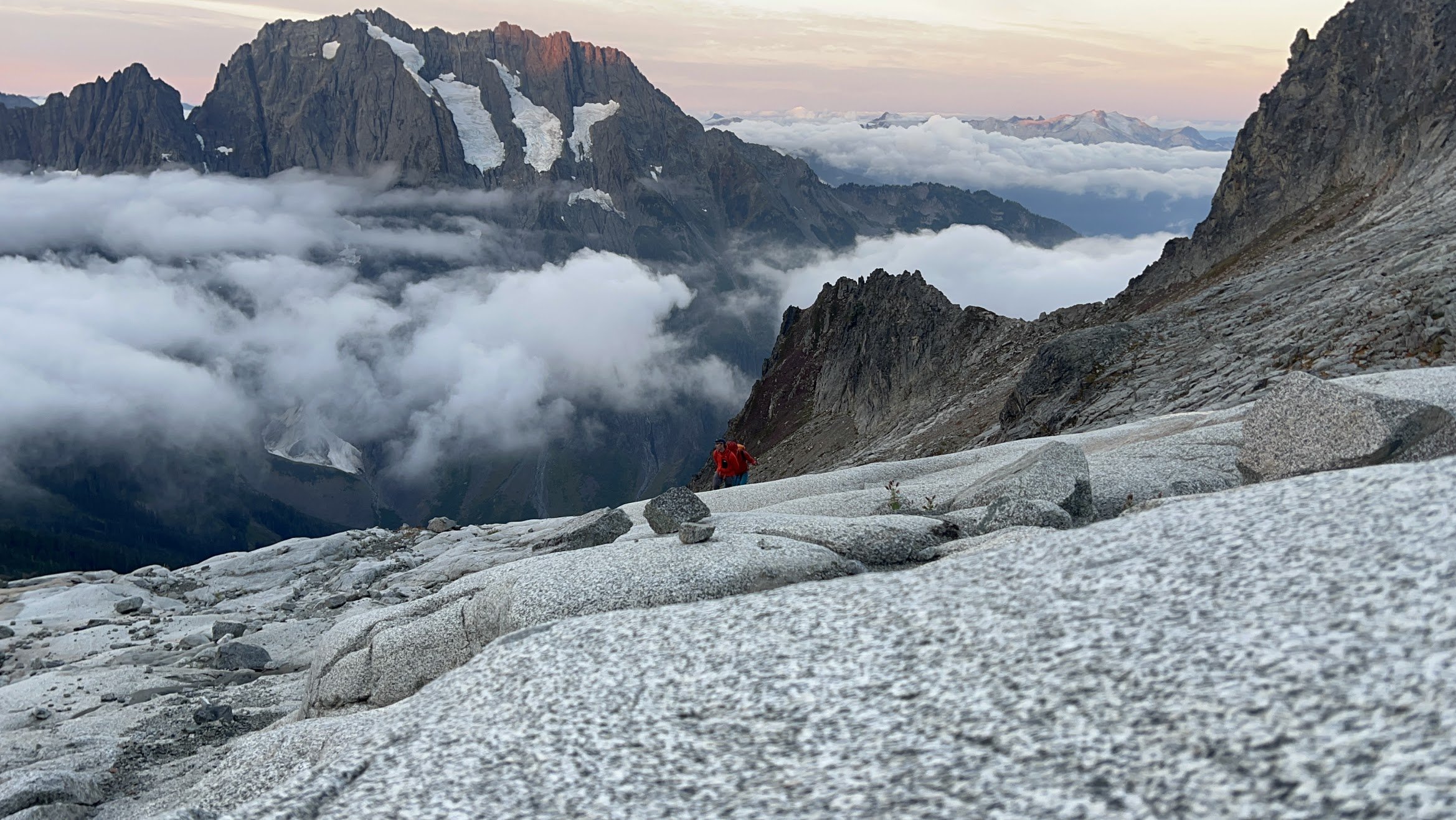History of guiding
THE ALPS
Mountain guiding is an age-old profession that has been around for literal centuries. It is a profession that requires a certain level of skill, knowledge, and experience to guide individuals through challenging mountainous terrain. So, we’re exploring the history of mountain guiding, focusing on the history of mountain guiding, starting in the Alps, then weaving the history of mountain guiding in the United States and how guides play a role now for the future generation.
History of Mountain Guiding in the Alps
The history of mountain guiding in the Alps dates back to the mid-19th century. During this time, wealthy individuals from England and other parts of Europe began to visit the Alps for leisure and exploration purposes. However, they lacked the skills and knowledge necessary to navigate the rugged and dangerous mountain terrain. As a result, local individuals who were familiar with the mountains began to offer their services as guides.
Initially, these guides were often shepherds or hunters who had grown up in the mountains and were intimately familiar with the terrain. However, as the demand for guiding services increased, more individuals began to take up the profession. These early mountain guides were known for their strength, courage, and knowledge of the mountains. Although strong, and knowledgeable, these locals would not be able to continue the pursuit of taking the high class into the mountains. In comes:
The formation of the mountain guiding federations in the Alps as a response to the increasing demand for guiding services and the need for standardized qualifications and standards. Prior to the formation of these federations, there was no unified system for certifying guides or regulating the profession. This lack of standardization led to inconsistencies in the quality of guiding services and safety issues for clients.
The International Federation of Mountain Guides Associations (IFMGA/UIAGM/IVBV) was established in 1965 as a response to these issues. The federation brought together national guiding associations from across the Alps to establish a unified system of qualifications and standards for mountain guides. The IFMGA requires rigorous training and certification for its guides and places a strong emphasis on safety and professionalism.
Similarly, the French Federation of Mountain and Climbing Guides (FFME) was formed in 1945 in response to the growing demand for guiding services in France. The federation established a standardized training and certification process for guides and helped to promote the profession of mountain guiding as a respected and professional career.
Overall, the formation of these guiding federations in the Alps helped to professionalize the profession of mountain guiding and ensure that clients could trust in the expertise and qualifications of their guides. The emphasis on safety and professionalism has helped to make mountain guiding a respected and highly regarded profession.
The main federations of mountain guides in the Alps include the International Federation of Mountain Guides Associations (IFMGA/UIAGM/IVBV), which was established in 1965, and the French Federation of Mountain and Climbing Guides (FFME).
In order to become a certified mountain guide, individuals must undergo a rigorous training and certification process that includes technical climbing skills, avalanche awareness, first aid, and other important competencies. Once certified, mountain guides are expected to adhere to a strict code of ethics and professionalism, which includes prioritizing the safety of their clients above all else.
The Professionalism of Mountain Guiding in the Alps
Mountain guiding in the Alps is a highly respected profession, and guides are viewed as experts in their field. In addition to technical climbing skills, mountain guides must also possess strong communication and leadership skills in order to effectively guide their clients through challenging terrain.
Guiding in the United States
This excerpt was penned by the AMGA, which does a great service to the history of the organization.
In the United States, mountain guiding has a different history and culture compared to the Alps. “Since the 1970s, several American groups tried their hand at guide certification, including the American Alpine Club. But it wasn’t until 1979 that the first real steps were made. In Jackson, Wyo., a group of guides decided to formalize an organization representing the greater guide community—the American Professional Mountain Guides Association (APMGA). Twelve guides—among them Jim Donini, Yvon Chouinard, and Peter Lev—penned the “Moose Bar Charter” on napkins in the Moose Bar.
However, the APMGA didn’t get very far either in uniting American guides or in getting UIAGM approval. As those climbers discovered (and embodied), the wildness and freedom of the mountain guide community would not easily be contained. Spread across the country, guides operated regionally, with little communication between each other. The international community was equally dismissive of America’s efforts. One request, long ago, for information from the UIAGM by Doug Robinson was met gruffly with a letter commenting on “monkeys without ropes”.
Thus, climbing standards were all but impossible to implement. But then the insurance crisis hit. From the mid-80s until 1990, insurance premiums rose and coverage became unavailable for many guides. Many faced the loss of their guide services or careers. Subsequently, this spurred John Fischer, owner of the Palisades School of Mountaineering, and Allan Pietrasanta, a guide, to try again to mobilize America’s guides.
“When the insurance crunch happened, everybody was in trouble,” said Pietrasanta. “But it was still really tough to unite everyone. The guides in the Northwest said, ‘We don’t need this,’ and the guides in Conway said, ‘Nobody cares about us out here.’ Everybody had their trips. There were a lot of big egos… hard to believe.” The two men also had a lot of difficulty getting the word out.
“It was hard to get everybody together; this was before the age of cell phones and internet,” he explained. But they persevered. And finally, a lot of people saw the light. Said Pietrasanta, “The seminal event in my mind for the AMGA, and the reason it exists today, was that meeting we finally had in ’86 at the Tetons Climbers’ Ranch.”
The well-attended meeting had its stressful moments though, he recalled. Support for the goal of international certification was not universal; many guides questioned the value of certification, much less UIAGM membership.
“But enough people saw the value in getting together,” said Pietrasanta. And so, a Board of Directors was organized, along with various committees. They determined the best way to support the profession would be to provide education, training, and credentials based on the already-established international (UIAGM) standards. As well, they would provide support where American guides needed it most—access to public lands, obtaining affordable insurance, and professionalization of the guiding profession.
“It was a labor of love for those early people who wanted guiding to be legitimized,” stated Pietrasanta. And, it worked. A Training and Certification Committee quickly began work on developing courses and ironing out the sticky issue of examination. They developed the Alpine and Rock disciplines first, and by the early 1990’s the structure and standards were beginning to take shape. The ski discipline continued to develop under the guidance of Doug Robinson, Allan Bard, Kirk Bachman, but primarily of Bela Vadasz and Jean Pavillard.
In 1993, under the leadership of then AMGA Executive Director Steve Young and after discussions with UIAGM President Leo Caminada, the AMGA made its official membership application to the UIAGM. Steve Young, Dunham Gooding, and Mark Houston traveled to Vent, Austria, to present the AMGA’s application at that year’s annual Meeting of the Delegates of the UIAGM.
The real work began at this point. Certification standards and examination methods were further refined, and course curricula readied for international observation—all under the watchful eye of the UIAGM. The Association of Canadian Mountain Guides became the AMGA’s sponsor country, responsible for overseeing the development and auditing of its programs. And the AMGA sent guides to Canada, New Zealand, and Switzerland to observe courses in action and to bring back new ideas for curricula, exam methods, and program structure.
Some of the AMGA’s Alpine and Rock courses were ready for review by UIAGM auditors in 1994, and in the fall of that year, Canadian Karl Klassen observed the Advanced Alpine Guide Course. Two years later Bruce Howatt officially (and favorably) reported on his observations of the Alpine Certification Exam. The Rock discipline developed apace. After an initial hiccup with a “too many cooks” ski seminar in the Sierra in the spring of 1993, the ski folks soon worked out issues stemming from the wide range of perspectives born in each of the various snowpack and mountain environments of the western United States.
Some memorable early events included one rock instructor running over Karl Klassen’s helmet in the Red Rocks parking area; UIAGM observer and President of the UIAGM’s Technical Commision Ernst Konzet remarking after a particularly nasty day on Mount Dana, “Zer is no such ting as bad vedder, only bad eqvipment!” Ernst’s slide show and report on this experience to the delegates of the UIAGM at the next Annual General Meeting emphasized the uniquely American elements of the guiding experience; the Las Vegas Strip, and Bishop’s celebrated Mule Days parade; somewhat less focus was on the more mundane aspects of ski mountaineering.
In the fall of 1997, beneath the shining glaciers of Austria’s Grossglockner, the AMGA was admitted as a member of the UIAGM. Sporting bolo ties provided by Bill Putnam, representatives, Matt Brooks, John Cleary (then President of the AMGA), Kathy Cosley, Randal Grandstaff, Houston, Pavillard, Ramsay Thomas, and Vadasz celebrated well into the night, along with their Swedish counterparts, also new members of the Federation.
The story of the AMGA and the IFMGA is far from over. The AMGA is a young member of an old Federation, and as the AMGA grows, the roles of the IFMGA in American guiding, and that of the AMGA in international guiding, remain to be discovered.
But what is certain, says Pietrasanta, is that “professionalism in American guiding has skyrocketed. More and more people can now make a good living off of their passion for being in the mountains and teaching people climbing and skiing.” And this is because of the efforts of the AMGA.”
The Role of Mountain Guides Today and for Future Generations
Mountain guides play a critical role in the world of climbing and mountaineering. They help individuals achieve their mountain objectives and do so safely. Additionally, mountain guides are often viewed as stewards of the mountains and are responsible for promoting responsible and sustainable mountain practices.
As the popularity of climbing and mountaineering continues to grow, the role of mountain guides will become increasingly important. In addition to guiding clients, they will also be responsible for promoting environmental conservation and helping to preserve the natural beauty of the mountains. As you read, mountain guiding has a rich and fascinating history that has evolved over the centuries. From its roots in the Alps to its current state in the US, mountain guiding has become a highly respected and professionalized profession. As the popularity of climbing and mountaineering continues to grow, the role of mountain guides will become increasingly important in ensuring that individuals can safely and responsibly explore the mountains for generations to come.








